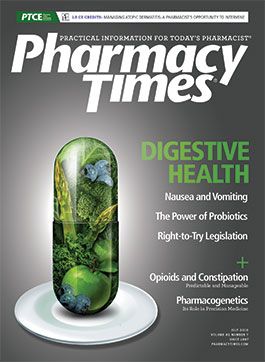Out of Crisis Comes Hope for Patients and Opportunity for Pharmacists
We can do more than act as dispensing police and check in with our state Prescription Drug Monitoring System; we can play an active role in preventing and treating this disease called drug addiction.
I was recently in Washington, DC, for 3 trips within 3 weeks that included meetings with 3 government agencies, multiple pharmacy associations, and multiple constituency-based organizations. The conversations were varied, but one question consistently arose within the first 30 minutes of each meeting: “What are you doing around opioid overuse?” This inquiry was followed closely by variations of the same overture: “If you could help solve that problem, it would bring immediate attention from the Administration, Congress, and governors across the country.”
Immediately prior to these DC-based interactions, I worked a shift at one of the many locations where I cover for vacationing pharmacists from time to time. At this pharmacy, as with most of the others, there would be the occasional patron who pays cash for a 1-cc pack of 10 syringes. However, on this Saturday, I counted 6 of these transactions—a more than 6-fold increase over my baseline experience.
All of these patrons appeared to be in need of help, but I didn’t really know what to do other than be kind and courteous and, in the most nonjudgmental way possible, retrieve the needles to sell to them. I felt helpless, without any ability (or knowledge) to contribute in any meaningful way to the trajectory of their lives, which will inevitably be defined by their ability to manage their addiction.
I still remember my first few shifts in a pharmacy with my newly minted license in 2002. The pharmacy’s drawers were filled to capacity with methadone, oxycodone, and the like. The thousand-count bottles of hydrocodone and acetaminophen were sometimes depleted in multiples per day. This continued for 5 to 7 years, and then we all awoke to the problem. Except, our solution was to squeeze the supply rather than temper demand. So the balloon was squeezed on one end, causing the other end to expand rapidly.
In rural North Carolina, a recent article titled “Is Heroin Explosion Imminent?”1 included 2 points that will stick with me for a while. The first is from Wilkes Sheriff Chris Shew, who said, “[We] can’t arrest ourselves out of this problem.” The second is from Dr. Jana Burson, medical director of Mountain Health Solutions in North Wilkesboro, who included the title “Heroin Comes to Town” in her blog as a way to describe the inevitable, as if watching storm clouds approach.
Fortunately, these clouds have some silver linings. Naloxone has broken down a number of historically entrenched and hierarchically formed silos in our system that are a barrier to public health efforts—and at a much more rapid pace than efforts to broaden immunization delivery and access. The availability of naloxone in pharmacies and among emergency medical services staff and other care team members for distribution and direct administration is now quite remarkable. Legislators and policy makers across the country have mobilized with relative urgency to act. This gives patients and their families and close friends some modicum of hope and reassurance because a lifesaving drug is now in their possession. In addition, this gesture of acknowledgement, that an individual may need one pharmaceutical to counteract a moment of desperation with another, indicates to affected individuals that the system may be willing to work with them, not against them.
And therein lies the opportunity for pharmacy to actively partner with physicians and other care team members in programs that prevent and treat opioid addiction. We can do more than act as dispensing police and check in with our state Prescription Drug Monitoring System; we can play an active role in preventing and treating this disease called drug addiction. We can do more than containment: we can be providers of care, in both regulatory and humanistic terms.
Let’s forge a path.
- Drug overdose is the leading cause of accidental death in the United States, with 47,055 lethal drug overdoses in 2014.2
- Opioid addiction is driving this epidemic, with 18,893 overdose deaths related to prescription pain relievers and 10,574 overdose deaths related to heroin in 2014.2
- Four of 5 new heroin users started out by misusing prescription painkillers.3
- The rate of heroin overdose deaths nearly quadrupled from 2000 to 2013.3
- During this 14-year period, the rate of heroin overdose showed an average increase of 6% per year from 2000 to 2010, followed by a larger average increase of 37% per year from 2010 to 2013.3
Troy Trygstad, PharmD, PhD, MBA, is vice president of Pharmacy Programs for Community Care of North Carolina (CCNC), which works collaboratively with more than 1800 medical practices to serve more than 1.6 million Medicaid, Medicare, commercially insured, and uninsured patients. He received his PharmD and MBA degrees from Drake University and a PhD in pharmaceutical outcomes and policy from the University of North Carolina.
References
- Hubbard J. Is heroin explosion imminent? Wilkes Journal-Patriot website. journalpatriot.com/news/is-heroin-explosion-imminent/article_61075470-3326-11e6-98c8-2780f55b8d58.html. June 15, 2016. Accessed June 16, 2016.
- CDC, National Center for Health Statistics, National Vital Statistics System, Mortality File. Number and age-adjusted rates of drug-poisoning deaths involving. opioid analgesics and heroin: United States, 2000-2014. cdc.gov/nchs/data/health_policy/AADR_drug_poisoning_involving_OA_Heroin_US_2000-2014.pdf. Published 2015. Accessed June 16, 2016.
- Hedegaard H, Chen L-H, Warner M. Drug-poisoning deaths involving heroin: United States, 2000-2013. CDC website. cdc.gov/nchs/products/databriefs/db190.htm. Published March 2015. Accessed June 16, 2016.

